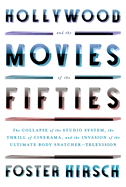
The 1950s were "the most turbulent decade in the history of the American filmmaking industry" and "the beginning of the end of the studio system in Old Hollywood," as Foster Hirsch (A Method to Their Madness) explains in his magisterial Hollywood and the Movies of the Fifties. To make his case, he revisits the films from that decade, when he was between the ages of seven and 17. Hirsch covers the old studio system in which moguls reigned supreme, as well as a new system that featured independent productions and stars who were no longer bound by long-term contracts. This caused more upheaval and challenges than modern filmgoers may realize. Hirsch documents them all with great insight and wit.
He describes technological changes and spectaculars intended to combat the advent of television--3-D; Cinerama; and the relative diversification of subject matter, "from the upper crust to the bottom of the barrel" and from literary adaptations like War and Peace to exploitation flicks like Attack of the 50 Ft. Woman. It's all here: flawed films about "wounds caused by racial injustice," the McCarthy-era blacklist, and the rise of "Method actors" like Marlon Brando and Audrey Hepburn. He highlights little-known facts, such as in the passage on Marilyn Monroe, where he notes "one of her most striking performances" from her early career--as a "psychotic babysitter" in Don't Bother to Knock. This is an excellent one-volume course on a pivotal period in film history. --Michael Magras, freelance book reviewer

